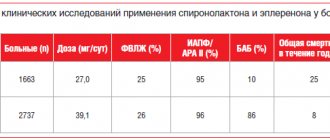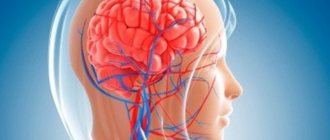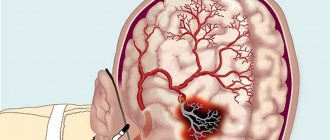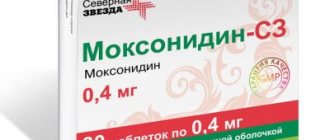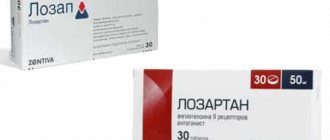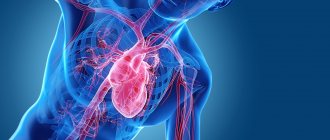Pharmacodynamics and pharmacokinetics
Reduces the flow of calcium into the cell, reduces the level of calcium in the plasmalemma depot, enhances the vasodilatory effect of carbon dioxide, reduces the tone of smooth muscle tissue of arterioles. Cinnarizine has a vasodilating effect and does not affect blood pressure.
The antihistamine activity of the drug is moderate, reduces the tone of the sympathetic nervous system, and moderately reduces the excitability of the vestibular apparatus.
Cinnarizine is effective in patients with a latent variant of cerebral circulatory insufficiency, with the initial form cerebral atherosclerosis a stroke . In persons with impaired peripheral circulation, it improves the nutrition of tissues, organs, myocardium, and increases post-ischemic dilation of the lumen of blood vessels. Cinnarizine reduces blood viscosity, moderately increases the ability of red blood cells to deform, and has a positive effect on the elasticity of their membranes.
Maximum absorption occurs within 1-3 hours. It is excreted in the form of metabolites in the urine by one third and in feces by two thirds. The half-life is 4-24 hours.
Nosological classification (ICD-10)
- H81.0 Meniere's disease
- H81.4 Dizziness of central origin
- H81.9 Vestibular function disorder, unspecified
- I73.0 Raynaud's syndrome
- I73.1 Thromboangiitis obliterans [Buerger's disease]
- I73.8 Other specified peripheral vascular diseases
- I73.9 Peripheral vascular disease, unspecified
- I79.2 Peripheral angiopathy in diseases classified elsewhere
- I80 Phlebitis and thrombophlebitis
- L98.4.2* Trophic skin ulcer
- R20.2 Paresthesia of the skin
- R25.2 Cramp and spasm
- R42 Dizziness and loss of stability
- T75.3 Motion sickness
Indications for use of Cinnarizine
What are the pills for? The drug is prescribed after an ischemic stroke , after suffering a brain injury, discirculatory encephalopathy , Minière's disease , vestibular disorders, for the prevention of kinetosis .
What other indications for the use of Cinnarizine exist? The medicine is effective for Raynaud's disease , thromboangiitis obliterans , senile dementia, migraine , sea and air sickness, atherosclerosis obliterans , thrombophlebitis , angiopathy , paresthesia , trophic disorders.
What does Cinnarizine help with?
The drug is prescribed for prophylactic and therapeutic purposes for a number of diseases and pathological conditions:
- The recovery period after an ischemic stroke.
- Disculatory encephalopathy.
- Raynaud's syndrome (vasospastic pathology).
- Minière's disease.
- Kinetoses of various origins.
- Condition after suffering traumatic injuries to the head and central nervous system.
- Obliterating atherosclerosis of cerebral vessels.
- Thromboangiitis and thrombophlebitis.
- Sea and mountain sickness.
Any condition accompanied by impaired blood circulation and nutrition of organs can cause the preventive or therapeutic use of Cinnarizine.
Side effects
Nervous system: increased fatigue, drowsiness, extrapyramidal disorders , depression , hyperkinesia , limb tremors, headaches.
Side effects from the digestive system: cholestatic jaundice , dyspeptic disorders, transient epigastric pain, dry mouth.
Rarely increased sweating , allergies , drop in blood pressure, lichen planus , and obesity .
Contraindications, side effects and overdose
The drug has a minimal number of contraindications for use, but they still exist. Cinnarizine is strictly prohibited during pregnancy and breastfeeding. It should also not be prescribed to children under 12 years of age.
A relative contraindication is Parkinson's disease. In this case, Cinnarizine can be used, but under the strict supervision of the attending physician.
Undesirable side reactions develop extremely rarely. Most often they are associated with individual intolerance to the main or auxiliary components of the drug. Some patients may experience weakness, fatigue, headaches, increased drowsiness, nausea, vomiting, stool disorders and dry mouth. It is extremely rare that taking Cinnarizine leads to hypotension and the development of depressive states.
The symptoms of overdose are similar to the manifestations of adverse reactions. If this condition develops, it is recommended to discontinue the drug, thoroughly rinse the stomach with clean water and take adsorbents (activated carbon or filtrum). There is currently no specific antidote.
Cinnarizine tablets, instructions for use (Method and dosage)
The drug is taken orally. There is no injection medicine.
If the blood supply to the brain is impaired: 25-50 milligrams three times a day.
If peripheral blood supply is impaired: 50-75 mg three times a day.
Prevention of sea and airborne illness: 30 minutes before the event, take 25 milligrams.
Labyrinthine disorders: 25 milligrams three times a day.
For children over 12 years of age, the dosage is halved. Age less than 12 years is a contraindication to using the drug.
The effect is achieved with continuous treatment.
Do not take more than 225 mg of medication per day.
Cinnarizine 25 mg No. 50 tablets
pharmachologic effect
Pharmaceutical group: blocker of “slow” calcium channels.
Pharmaceutical action: Selective BMCC, reduces the entry of Ca2+ into cells and reduces their concentration in the plasmalemma depot, reduces the tone of smooth muscles of arterioles, enhances the vasodilating effect of carbon dioxide.
Directly affecting the smooth muscles of blood vessels, it reduces their response to nutrients (adrenaline, norepinephrine, dopamine, angiotensin, vasopressin). It has a vasodilating effect (especially in relation to cerebral vessels), without having a significant effect on blood pressure.
It exhibits moderate antihistamine activity, reduces the excitability of the vestibular apparatus, and lowers the tone of the sympathetic nervous system.
Effective in patients with latent cerebral circulatory failure, initial cerebral atherosclerosis and chronic cerebral vascular diseases with post-stroke focal symptoms. In patients with impaired peripheral circulation, it improves blood supply to organs and tissues (including the myocardium), enhances post-ischemic vasodilation.
Increases the elasticity of red blood cell membranes, their ability to deform, and reduces blood viscosity. Increases muscle resistance to hypoxia.
Pharmacokinetics: TCmax after oral administration - 1-3 hours, binding to plasma proteins - 91%.
Completely metabolized in the liver (via dealkylation). T1/2 - 4 hours.
Excreted in the form of metabolites: 1/3 - by the kidneys and 2/3 - with feces.
Indications
Chronic cerebrovascular insufficiency (dizziness, tinnitus, headache, memory impairment, decreased concentration).
Vestibular disorders (including Meniere's disease, dizziness, tinnitus, nystagmus, nausea and vomiting of labyrinthine origin).
Prevention of kinetosis (“road sickness” - sea and air sickness).
Migraine (prevention of attacks).
Peripheral circulation disorders (“intermittent” claudication, Raynaud’s disease, diabetic angiopathy, thrombophlebitis, trophic disorders, including trophic and varicose ulcers).
Contraindications
Hypersensitivity, pregnancy, lactation, children under 5 years of age.
Carefully. For dosage forms containing lactose (additionally): lactose intolerance, lactase deficiency, glucose-galactose malabsorption syndrome.
Side effects
From the nervous system: drowsiness, increased fatigue, headache, extrapyramidal disorders (tremor of the limbs and increased muscle tone, hypokinesia), depression.
From the digestive system: dryness of the oral mucosa, pain in the epigastric region, dyspepsia, cholestatic jaundice.
From the skin: increased sweating, lichen planus (extremely rare).
Allergic reactions: skin rash.
Other: decreased blood pressure, increased body weight, lupus-like syndrome.
Interaction
Strengthens the effect of ethanol, sedatives, tricyclic antidepressants.
How to take, course of administration and dosage
Inside, after eating.
For chronic cerebrovascular insufficiency - 25 mg 3 times a day, in drops - 8 drops 3 times a day or 1 capsule (75 mg) 1 time a day.
If peripheral circulation is impaired - 50-75 mg 3 times a day.
To prevent seasickness and air sickness - 25 mg 30 minutes before the upcoming trip, if necessary, repeat the dose after 6 hours; for children over 5 years old - 1/2 dose for adults.
For vestibular disorders - 25 mg 3 times a day. For children, the dose is reduced by 2 times.
The maximum daily dose should not exceed 225 mg. In case of high sensitivity to the drug, treatment begins with 1/2 dose, increasing it gradually.
To achieve an optimal therapeutic effect, the drug should be taken continuously, for a long time - from several weeks to several months.
Overdose
Symptoms: vomiting, drowsiness, tremor, excessive decrease in blood pressure, coma.
Treatment: there is no specific antidote, gastric lavage, activated charcoal, symptomatic therapy.
Special instructions
Due to the presence of an antihistamine effect, cinnarizine can affect the results of anti-doping control of athletes (false-positive results), as well as neutralize positive reactions during skin diagnostic tests (treatment should be discontinued 4 days before the test).
With long-term use, it is recommended to conduct a control examination of liver function, kidney function, and peripheral blood patterns.
Women taking cinnarizine are not recommended to breastfeed.
Patients with Parkinson's disease should be prescribed only in cases where the benefits of its use outweigh the possible risk of worsening the condition.
During the treatment period, care must be taken when driving vehicles and engaging in other potentially hazardous activities that require increased concentration and speed of psychomotor reactions.
special instructions
Cinnarizine may cause false positive doping tests in athletes. This effect is explained by the antihistamine effect of the drug. Long-term use requires monitoring the functioning of the liver, kidneys, and blood condition. It is acceptable to take the drug while breastfeeding. Affects transport management.
A combination of Cinnarizine and Piracetam for chronic cerebrovascular insufficiency. The interaction of these substances is described in detail on Wikipedia.
Cinnarizine
Cinnarizine is a drug that blocks the so-called. “slow” calcium channels, mainly in cerebral vessels. The drug inhibits the process of calcium entry into cells, reduces their concentration in plasmalemma depots, has a relaxing effect on the smooth muscle frame of small arteries, and potentiates the vasodilating effect of carbon dioxide. By directly acting on the smooth muscles of blood vessels, it reduces their sensitivity to biogenic vasoconstrictor compounds (catecholamines). It exhibits a vasodilating effect (especially in relation to cerebral vessels), with virtually no effect on blood pressure. Exhibits antihistamine properties, reducing the reactivity of the vestibular apparatus and sympathetic tone. Cinnarizine is effective in patients with latent cerebrovascular insufficiency, nascent atherosclerosis of cerebral vessels, chronic vascular diseases and signs of post-stroke focal lesions. In patients with peripheral vascular lesions, cinnarizine improves blood supply to affected organs and tissues (including the heart) and enhances post-ischemic vasodilation. The drug increases the elasticity of erythrocyte membranes, their deformability, improves the rheological characteristics of blood, and increases muscle resistance to oxygen starvation. The maximum concentration of the active substance in the blood after oral administration is achieved after 1-3 hours. The drug is completely metabolized by microsomal liver enzymes. The half-life of cinnarizine is 2-4 hours. It is excreted by the intestines (most of it) and by the kidneys.
Cinnarizine is available in tablets. The drug should be taken after meals. For cerebral circulation disorders - 25-50 mg three times a day, for circulatory disorders in peripheral vessels - 50-75 mg three times a day, for labyrinthine-vestibular dysfunctions - 25 mg three times a day, for kinetosis, adults take before a planned trip 25 mg each with the possibility of taking an additional dose after 6 hours; children take half of the indicated dose.
The maximum daily dose of cinnarizine is 225 mg. In case of hypersensitivity to the drug, the drug course begins with half the dose, gradually increasing it until an optimal therapeutic response is obtained. The duration of pharmacotherapy varies from 2-3 weeks to several months. At the initial stage of treatment, you should stop taking ethanol in any form. Due to the presence of antihistamine activity in cinnarizine, the drug can give a positive result in a doping test in athletes, as well as mask positive reactions in diagnostic skin tests (in this regard, treatment should be interrupted 4 days before the test). During long-term drug courses, it is recommended to periodically monitor the functional parameters of the liver and kidneys, as well as the picture of peripheral blood. Patients suffering from Parkinson's disease should be prescribed cinnarizine with extreme caution. The drug potentiates the effect of ethanol, sedatives and antidepressants. When used together with nootropics, vasodilators and antihypertensive drugs, cinnarizine enhances their effect. The drug plays a particularly important role in geriatric practice. Cerebrovascular insufficiency, which progresses with age, interferes with the normal blood supply to brain tissue, resulting in the gradual death of brain neurons. One of the reasons on which the severity of brain function disorders depends is atherosclerotic vascular changes. In some cases, this factor begins to play a decisive role, as, for example, in senile dementia. The goal of treatment in older patients is to slow age-related structural and functional changes. Considering the direct effect of cinnarizine on the blood vessels of the brain, it is one of the most prescribed drugs for patients of this profile.
Cinnarizine analogs
Level 4 ATX code matches: Betagis
Stugeron
Betaserk
Betaver
Westinorm
Westicap
Betagistine
Tagista
Vestibo
An analogue of the drug is Stugeron .
Cinnarizine price, where to buy
The price of Cinnarizine tablets is about 60 rubles for 50 pieces.
- Online pharmacies in RussiaRussia
- Online pharmacies in UkraineUkraine
- Online pharmacies in KazakhstanKazakhstan
ZdravCity
- Cinnarizine tablets 25 mg 50 pcs. Pharma AD
69 rub. order - Cinnarizine tablets 25 mg 50 pcs. OzonOzon LLC
67 RUR order
- Cinnarizine tablets 25 mg 50 pcs. Sopharma AD
84 rub. order
- Cinnarizine tablets 25mg 56pcs AO Update PFC
101 rub. order
- Cinnarizine Avexima tablets 25 mg 50 pcs. LLC Avexima Siberia
72 RUR order
Pharmacy Dialogue
- Cinnarizine (tab. No. 50)Sopharma
77 RUR order
- Cinnarizine tablets No. 50Balkanpharma
71 RUR order
- Cinnarizine (tab. No. 50)Pharma AD
68 RUR order
- Cinnarizine (tab. No. 56)Update of PFC CJSC
94 RUR order
- Cinnarizine (tab. No. 50)Pharma AD
63 RUR order
show more
Pharmacy24
- Cinnarizine 25 mg N50 tablets AT "Lekhim-Kharkiv", Ukraine
13 UAH.order - Cinnarizine-KMP forte 75 mg N20 tablets PAT "Kievmedpreparat", Ukraine
33 UAH order
- Cinnarizine Sopharma 25 mg N50 tablets PAT "Vitamin" Ukraine
19 UAH order
PaniPharmacy
- Cinnarizine tablets Cinnarizine tablets. 25mg No. 50 Ukraine, Lekhim-Kharkov CJSC
12 UAH order
- Cinnarizine forte tablets Cinnarizine forte tablets. 75 mg No. 20 Ukraine, Kievmedpreparat OJSC
39 UAH order
- Cinnarizine tablets Cinnarizine tablets. 25 mg No. 50 Bulgaria, Sopharma
23 UAH order
show more


